Ger your Bali Car Rental In Ubud

Ubud, the cultural heart of Bali, is a destination that beckons travelers with its lush landscapes, vibrant arts scene, and serene atmosphere. While walking through the narrow streets and exploring the rice terraces can be enchanting, having the freedom to roam at your own pace is an experience unparalleled. This is where Balisakti Bali Car Rental steps in, offering you the keys to unlocking the hidden gems of Ubud.
Why Choose Balisakti Bali Car Rental?
Balisakti Bali Car Rental is not just another car rental service; it is your gateway to hassle-free exploration. Here are some reasons why choosing Balisakti is the best decision for your Ubud adventure:
1. Diverse Fleet of Vehicles:
Whether you’re a solo traveler, a couple on a romantic getaway, or a family seeking adventure, Balisakti Bali Car Rental has a diverse fleet of vehicles to suit your needs. From compact cars to spacious SUVs, their well-maintained and modern cars ensure a comfortable and safe journey.
2. Affordable Rates:
Balisakti understands the importance of budget-friendly options for travelers. Their rental rates are not only competitive but also transparent, with no hidden fees. You can enjoy the freedom of exploring Ubud without breaking the bank.
3. Flexible Rental Periods:
Whether you plan to spend a day or a week in Ubud, Balisakti Bali Car Rental offers flexible rental periods to accommodate your schedule. Enjoy the convenience of picking up and dropping off your rental at a time that suits you best.
4. Comprehensive Insurance:
Safety is a top priority at Balisakti Bali Car Rental. Each vehicle comes with comprehensive insurance coverage, providing you with peace of mind as you traverse the scenic roads of Ubud. Focus on creating memories while they take care of the rest.
How to Rent a Car with Balisakti Bali Car Rental:
Renting a car with Balisakti is a straightforward process that ensures a seamless start to your Ubud adventure. Follow these simple steps:
1. Visit the Balisakti Bali Car Rental Website:
Navigate to the official website of Balisakti Bali Car Rental. Here, you can explore their fleet, check rental rates, and gather all the necessary information.
2. Select Your Ideal Vehicle:
Choose a vehicle that suits your needs and preferences. Consider factors such as the number of passengers, luggage space, and desired features.
3. Make a Reservation:
Once you’ve selected your ideal car, proceed to make a reservation. Provide the required details, including your rental dates and any additional services you may need.
4. Pick Up Your Rental:
On the day of your rental, head to the designated Balisakti Bali Car Rental location in Ubud. The friendly and professional staff will ensure a quick and efficient handover of the keys.
5. Enjoy Your Ubud Adventure:
With the keys to your rental car in hand, set off to explore the beauty of Ubud at your own pace. Visit the iconic Monkey Forest, experience traditional Balinese dance performances, and discover the local art markets—all on your own schedule.
Recommended place that you can visit with self driving car in Ubud
Ubud Monkey Forest
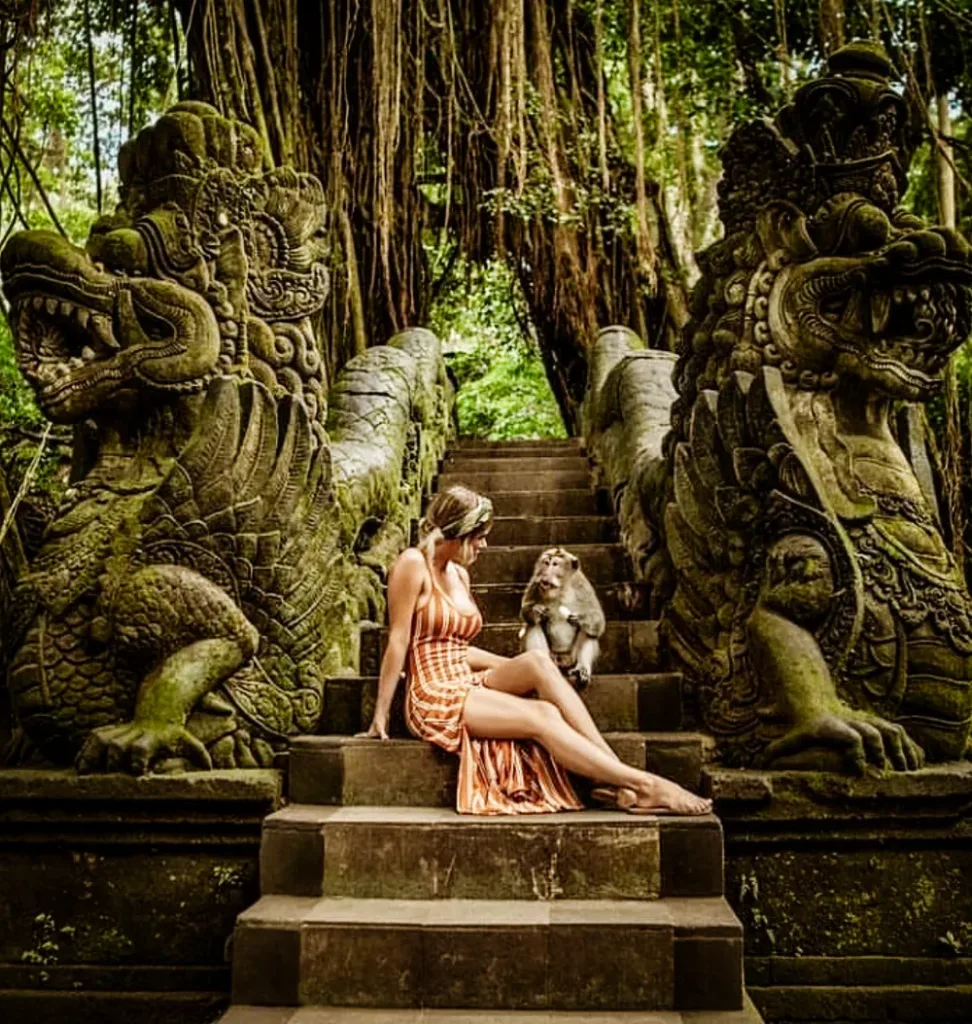
No trip to Ubud is complete without a visit to the iconic Ubud Monkey Forest, and with the convenience of a car rental from Balisakti Bali Car Rental, you can explore this enchanting destination with ease.
About Ubud Monkey Forest:
Nestled in the heart of Ubud, the Monkey Forest Sanctuary is a lush haven that combines nature, culture, and a playful troop of long-tailed macaques. Officially known as the Padangtegal Mandala Wisata Wanara Wana Sacred Monkey Forest Sanctuary, it’s a conservation area that not only provides a home for these mischievous creatures but also showcases ancient Balinese architecture and sacred temples.
What to Expect:
As you stroll through the Monkey Forest, be prepared for an immersive experience with the resident macaques. These curious and lively creatures are accustomed to human presence, making it possible for visitors to observe them up close. It’s a delightful opportunity for unique photo moments and a chance to witness their playful antics in a natural setting.
Sacred Temples and Ancient Artifacts:
Within the Monkey Forest, you’ll discover several ancient temples, including the Pura Dalem Agung Padangtegal, which dates back to the 14th century. These temples are not only architectural marvels but also hold cultural and spiritual significance. Take your time to explore the intricately carved stone structures and moss-covered statues that add to the mystical ambiance of the forest.
Tips for Visitors:
- Respect the Monkeys: While the macaques are accustomed to human presence, it’s essential to respect their space and not feed them. Visitors are advised to keep a safe distance and avoid direct eye contact.
- Dress Appropriately: As you may explore both the forest and sacred temples, dress modestly out of respect for the cultural and religious significance of the site.
Tegalalang Ubud Rice Terrace
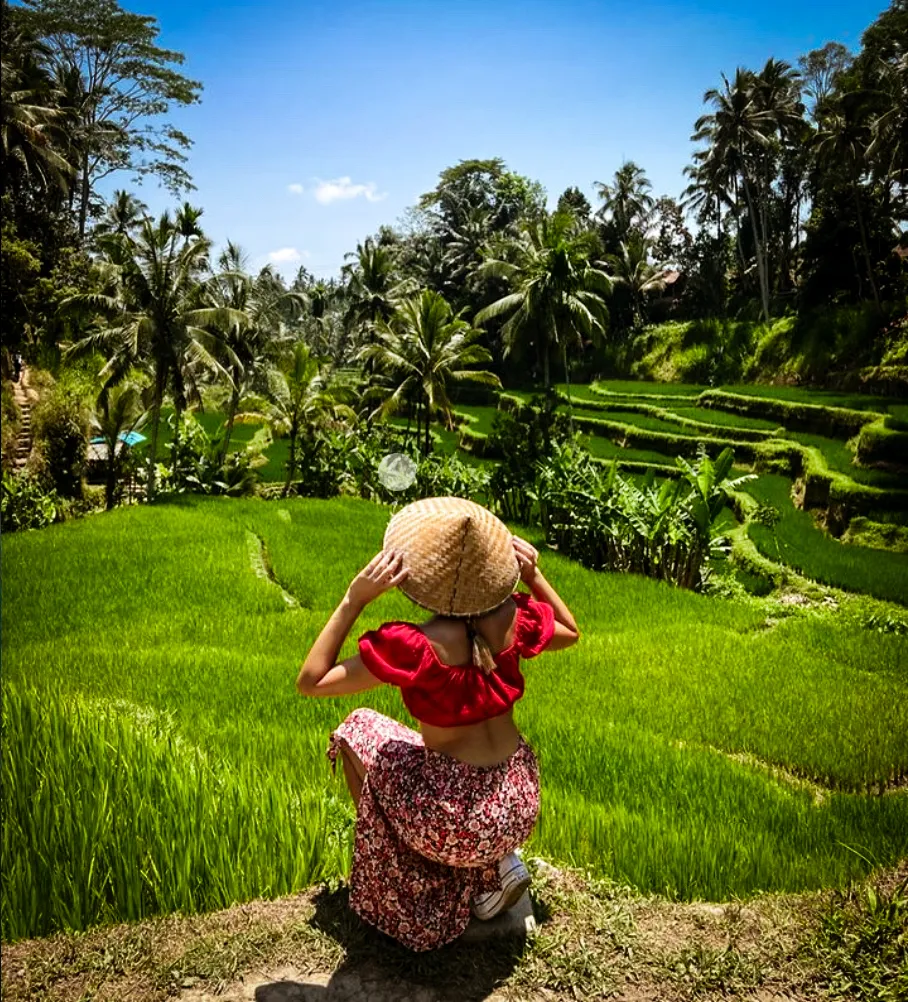
Tegallalang Rice Terrace is a famous tourist destination located in the Tegallalang village in the Gianyar Regency of Bali, Indonesia. It is renowned for its stunning and picturesque landscapes of rice paddies, which are meticulously carved into the contours of the hilly terrain. The terrace design follows the traditional Balinese irrigation system known as “Subak,” which dates back over a thousand years.
Key features of Tegallalang Rice Terrace include:
- Scenic Beauty: The Tegallalang Rice Terrace offers breathtaking panoramic views of lush green rice fields that stretch across the hills and valleys. Visitors are often captivated by the beauty of the intricate patterns created by the tiered landscape.
- Cultural Significance: The rice terrace is not only a visual spectacle but also holds cultural and historical significance for the Balinese people. The Subak system, which manages the complex irrigation network, reflects the traditional cooperative water management system in Bali, recognized by UNESCO as a cultural landscape.
- Tourism Attraction: Tegallalang Rice Terrace has become a major tourist attraction in Bali, drawing visitors from around the world who come to appreciate the natural beauty, take photographs, and explore the terraced fields.
- Local Agriculture: Despite its popularity among tourists, Tegallalang Rice Terrace remains a working agricultural landscape. Local farmers cultivate rice using traditional methods, and the site is an important source of livelihood for the surrounding communities.
- Art and Craft Stalls: Along the roads surrounding the rice terrace, there are often numerous art and craft stalls. Local artisans sell a variety of handmade goods, including traditional Balinese crafts, clothing, and souvenirs.
- Cafes and Restaurants: There are also cafes and restaurants with terraces overlooking the rice fields. Visitors can enjoy a meal or a cup of coffee while taking in the stunning views.
It’s important to note that, due to its popularity, Tegallalang Rice Terrace can get crowded, especially during peak tourist seasons. Visitors are encouraged to be respectful of the local environment and the farmers who work the land. Exploring the terrace on foot or through designated paths provides a more immersive experience and allows for a closer look at the traditional agricultural practices.
Gunung Kawi Sebatu Temple
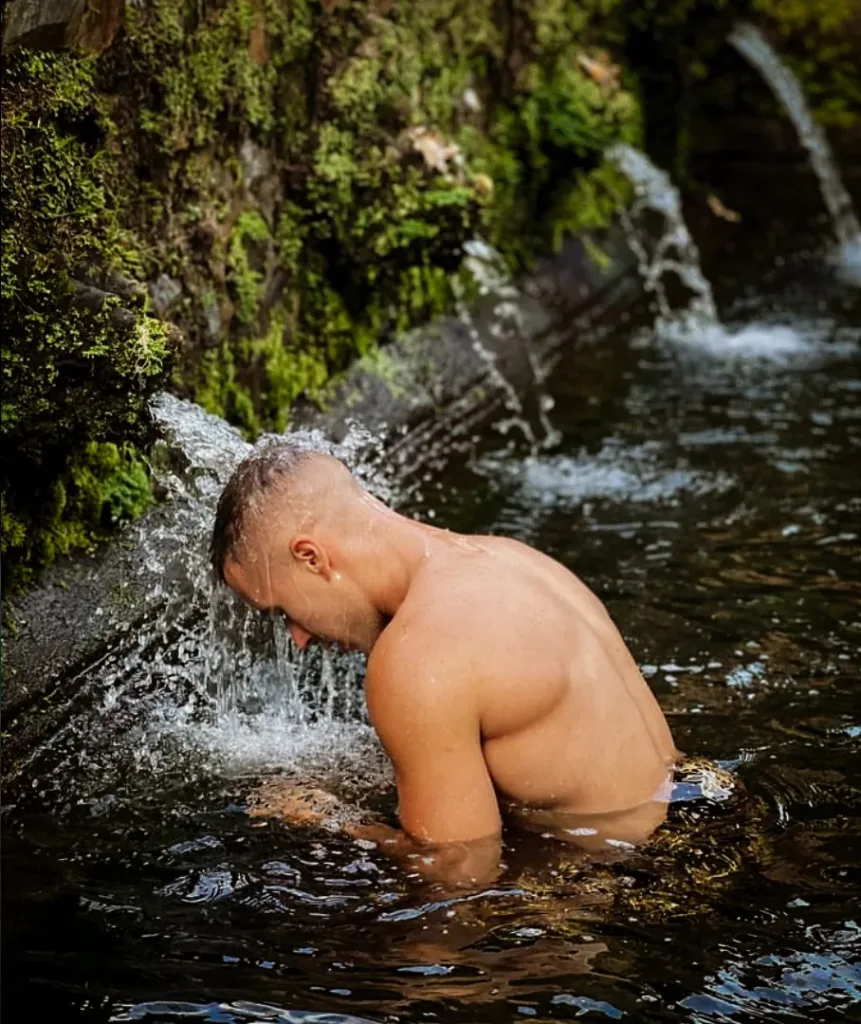
Gunung Kawi Sebatu Temple, commonly known as Sebatu Temple, is a beautiful water temple located in the village of Sebatu, Tegallalang, in the Gianyar Regency of Bali, Indonesia. It is situated in the central part of the island, not far from Ubud, and is known for its tranquil setting, lush surroundings, and sacred water features. Here are some key aspects of Gunung Kawi Sebatu Temple:
- Spiritual Significance: Gunung Kawi Sebatu is a Hindu-Balinese temple that holds significant spiritual importance for the local community. The temple is dedicated to the Hindu god Vishnu and is considered a place of purification and spiritual cleansing.
- Holy Spring Water: One of the highlights of the temple is its sacred spring water. Pilgrims and visitors alike believe that the holy water from the temple’s natural springs possesses purifying properties. It is common for people to bathe in these waters as part of a ritual to cleanse their body and soul.
- Architectural Features: The temple complex features traditional Balinese temple architecture with elaborately carved stone shrines, pavilions, and statues. The intricate stone carvings depict scenes from Hindu mythology and showcase the artistic craftsmanship of the Balinese people.
- Courtyard and Gardens: The temple is set within a lush and well-maintained courtyard surrounded by tropical gardens. The serene atmosphere is enhanced by koi ponds and lotus-filled pools, creating a peaceful and meditative environment.
- Holy Fish Sanctuary: The ponds in and around the temple are home to numerous colorful carp and koi fish. These fish are considered sacred and are protected within the temple complex. Visitors often find joy in feeding the fish as part of their experience at Gunung Kawi Sebatu.
- Cultural Practices: Gunung Kawi Sebatu is an active place of worship, and visitors are expected to dress modestly when entering the temple premises. Sarongs and sashes are often provided for those who need to cover up before entering the sacred areas.
- Visiting Tips: To fully appreciate the spiritual and cultural aspects of Gunung Kawi Sebatu Temple, it is recommended to visit during a quiet time to avoid crowds. Early mornings or weekdays are generally less busy.
The temple is not as well-known as some of Bali’s more famous temples, making it a more serene and less crowded destination. It offers a peaceful retreat for those seeking a spiritual experience and a connection with Bali’s rich cultural heritage.
Tirta Empul Temple
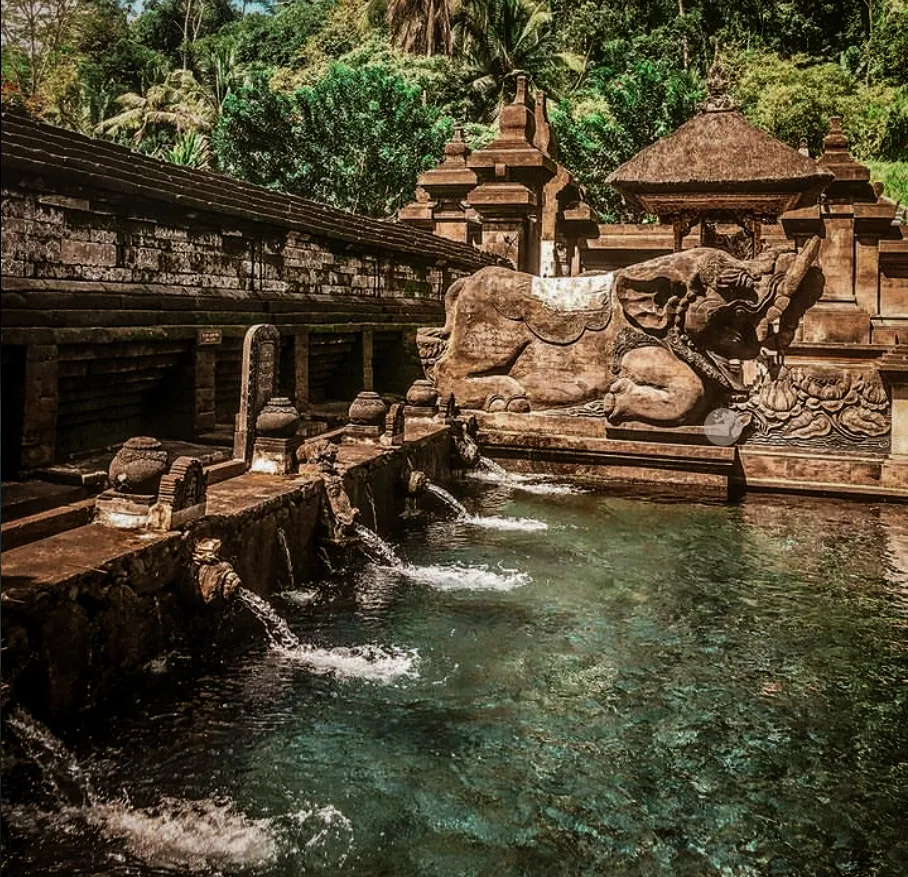
Tirta Empul Temple, also known as Pura Tirta Empul, is a Hindu Balinese water temple located near the town of Tampaksiring, in the Gianyar Regency of Bali, Indonesia. The temple is famous for its sacred springs, which are believed to have curative properties. Tirta Empul is one of Bali’s most important and holiest temples, and it is a popular destination for both tourists and Balinese Hindus. Here are key features and aspects of Tirta Empul Temple:
- Sacred Springs: The main attraction of Tirta Empul is its sacred springs, which are the source of the Pakerisan River. The temple complex consists of a series of courtyards and pools fed by these holy springs. The water is believed to have magical and purifying properties, and it is used for ritual purification by Balinese Hindus.
- Ritual Purification: Pilgrims and visitors come to Tirta Empul to participate in a traditional ritual of purification. The process involves a series of steps, including prayer, meditation, and bathing in the holy springs. Each spring has a specific purpose, and people believe that the ritual cleanses them spiritually and physically.
- Architecture: The temple complex itself is a blend of Balinese and Javanese architectural styles. Intricate stone carvings, sculptures, and traditional Balinese structures adorn the site. The central courtyard features a large rectangular pool with 30 water spouts, each representing a different Hindu deity.
- Tirta Empul Legend: According to Balinese legend, the temple was created by the god Indra. The sacred springs at Tirta Empul are said to have originated from the ground when Indra pierced it to create a source of water for his troops during a battle with a demon king.
- Holy Shrines and Statues: Within the temple complex, there are shrines dedicated to various deities, including Shiva, Vishnu, and Brahma. Visitors will also find statues and sculptures depicting scenes from Hindu mythology.
- Festivals and Ceremonies: Tirta Empul is a site of regular ceremonies and festivals, especially during the major Balinese Hindu festivals. These events attract locals and tourists alike, offering a vibrant display of Balinese culture and religious practices.
- Visiting Tips: Visitors to Tirta Empul should dress modestly, and it’s customary to wear a sarong and sash within the temple premises. It’s also recommended to be respectful of the ongoing rituals and ceremonies and to follow the guidance of the temple priests.
Tirta Empul Temple provides a unique and immersive experience for those interested in Balinese Hindu culture and spirituality. The combination of its historical significance, architectural beauty, and the ritualistic bathing practices make it a must-visit destination in Bali.
Tibumana Waterfall
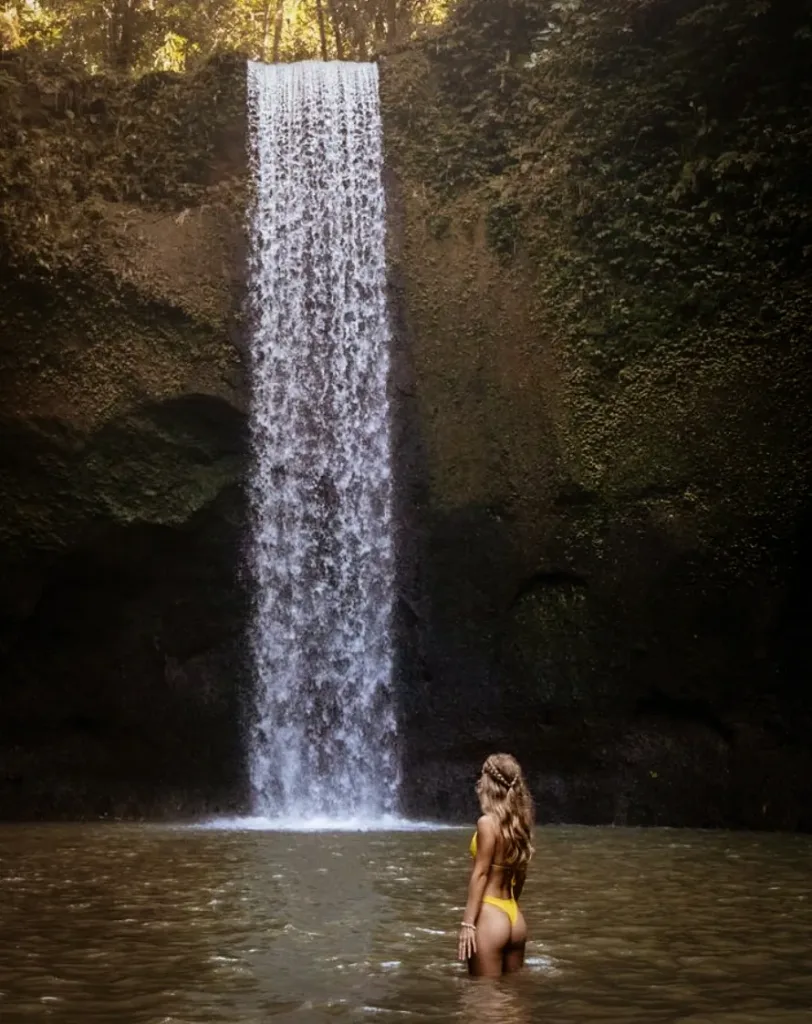
Tibumana Waterfall is a stunning natural attraction located in Bangli, Bali, Indonesia. However, please note that conditions and details might have changed, so it’s a good idea to check the latest information before planning a visit.
Here’s some information about Tibumana Waterfall:
- Location: Tibumana Waterfall is situated in the Bangli regency, which is known for its lush landscapes and traditional Balinese villages. It’s relatively close to Ubud, one of Bali’s major tourist destinations.
- Scenic Setting: The waterfall is set amid lush greenery and tropical foliage, creating a picturesque and tranquil environment. The surrounding area is often considered a hidden gem, offering visitors a serene escape from the bustling tourist areas.
- Accessibility: The waterfall is accessible via a short trek from the parking area. The trek is generally considered easy, making it suitable for visitors of various fitness levels. Along the way, you can enjoy the natural beauty of the landscape.
- Waterfall Features: Tibumana Waterfall cascades from a height into a pool below, creating a refreshing and inviting atmosphere. The pool at the base of the waterfall is suitable for swimming, providing a unique opportunity to cool off in the natural surroundings.
- Local Community: The waterfall is located in a rural area, allowing visitors to experience the traditional Balinese way of life. Local communities in the vicinity often play a role in maintaining and preserving the natural beauty of the site.
- Visiting Tips:
- It’s advisable to wear comfortable clothing and suitable footwear for the short trek to the waterfall.
- Entrance fees may be required, and there might be facilities such as changing rooms or rest areas nearby.
- It’s a good idea to check weather conditions before visiting, as heavy rainfall can affect the accessibility and safety of the area.
- Tourist Experience: Tibumana Waterfall provides a more secluded and less crowded alternative to some of Bali’s more popular waterfalls. The natural setting and the relatively undeveloped surroundings contribute to a more authentic and peaceful experience.
Remember to check for any updates or changes in access conditions before planning your visit, as tourism sites can undergo changes, and new information may have emerged since my last update.
Balisakti Bali Car Rental is not just a car rental service; it’s a partner in your Ubud exploration. With a commitment to affordability, flexibility, and safety, Balisakti ensures that your journey through the cultural heart of Bali is nothing short of extraordinary. So, get ready to embark on a road trip of a lifetime with Balisakti Bali Car Rental as your trusted companion.



